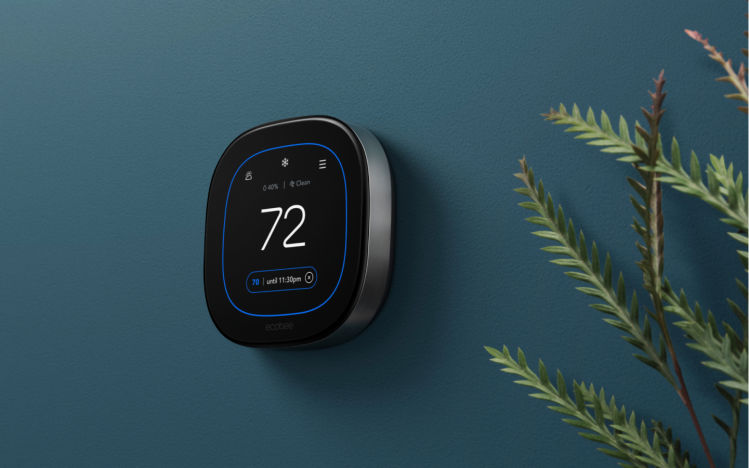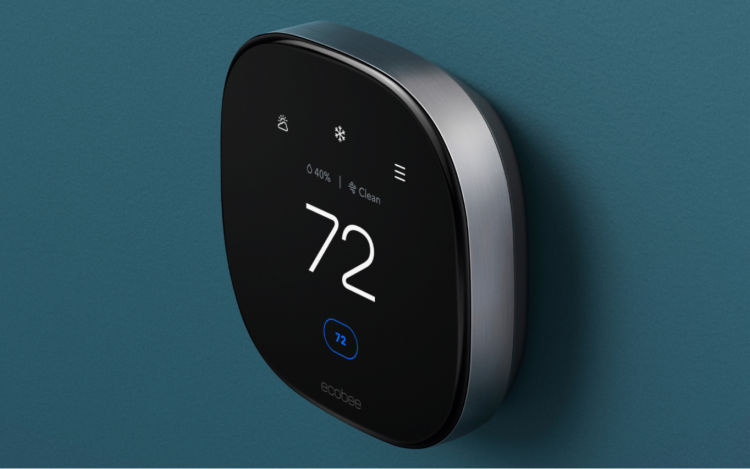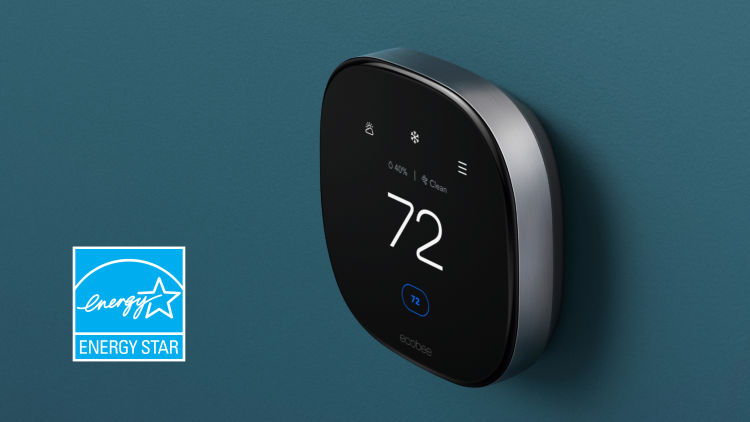The Inside Story Behind ecobee’s All-New Smart Thermostats
Jonathan Hayes, ecobee’s design chief, gives us the low-down on the all-new Smart Thermostat Premium and Smart Thermostat Enhanced.
by ecobee on 05/17/2022 in Experts
10 min read

ecobee’s all-new Smart Thermostat Premium and Smart Thermostat Enhanced push the boundaries of what a smart thermostat can do—to improve comfort, home health, and security—while delivering the energy-saving features you expect from the inventor of the smart thermostat.
We sat down with Jonathan Hayes, ecobee’s vice president of design and experience, to learn the true story behind the design choices and new features that mark an exciting new chapter in ecobee’s product evolution.
ecobee Citizen: Good morning, Jonathan. Could you start by taking us through initial planning and the ecobee team’s motivations for launching two completely redesigned thermostats?
Hayes: We began planning for a new device with the goal of taking everything we had learned since our founding in 2007 and turning it into the best new hardware product our customers had ever seen.
As we were evolving the design, we decided to aim our efforts at what we call “Winning on Design” — meaning we would optimize aesthetics and not cut any corners.
By this time, ecobee had just refined and relaunched its brand with a new logotype and a deeper emphasis on our core brand shape: a circle/square hybrid we call the “squircle.” Innovating every aspect of our existing design, we built around a new “squircular” display that’s 50% larger. And within the display, there’s a further integration between the industrial design and the user interface where we use the same design language.
For instance, we array our icons in an arc along the squircle, and when you change the temperature, we have a heating or cooling squircle that mirrors the main industrial design shape.

When your thermostat is heating or cooling, ecobee’s squircle frames the display in orange or blue—an easy visual cue that your system is running.
In this way, we achieved seamless consistency across hardware and software, or more so across industrial design and interaction or interface, and even packaging. But really, the experience should feel like it all came from one hand, because it did.
The reason we are launching two products is that the glass, display and new interface are so compelling that we wanted to make those features available to people who happen to be less interested in our flagship features: voice control, air quality monitoring, and the metal body. Smart Thermostat Enhanced was built for that group.
ecobee Citizen: I wouldn’t have guessed this, but after unboxing the Premium model and holding it in my hands, I was immediately taken by, of all things, its heft. It is clear that there’s been more of, if you’ll excuse the pun, a ‘premium’ put on the quality of the materials, and that comes across when you see it and hold it in your hands.
Hayes: You’re exactly right! When you take Smart Thermostat Premium in your hands, besides its beauty, what people notice immediately is its density.
It is absolutely full, very efficiently configuring all sorts of components — so kudos to my hardware, mechanical, and manufacturing partners. It has a speaker, microphones, an occupancy sensor, and an indoor air quality sensor, which we know from our testing that people value highly. But it also has a metal body and the weight of that metal body, which is not a thin part. So collectively, all the parts add up to the density you’d expect of a solid metal object.

The metal body exemplifies our commitment to craftmanship, and our dedication to beautifying our customer’s homes. It’s also a structural component that everything is bolted to, like a chassis. What it gives you is an even higher level of robustness than before.
The soft edges on the thicker, higher-quality glass display mean it’s completely rounded—in both dimensions. We call them waterfall edges. If you were to swipe the temperature picker and your finger were to go all the way off the glass, the last touch would be smooth; your finger would just slide off that waterfall. Glass is a hard substance but the waterfall makes it look soft.
There aren’t two more neutral materials than black glass and satin-plated zinc. It doesn’t matter what your home décor style is, it will look great. And it’s going to give a premium and timeless look that you just can’t achieve with plastic.

This also ties back to our belief in building long-lasting products. Marc Newson, the great Australian industrial designer, once said ‘Sustainability is when you only ever have to buy one.’ Sustainability is in our DNA. We design these things to last, and last, and last, and we wanted to signal that with the metal body, thick glass, and the machined precision throughout.
ecobee Citizen: Let’s circle back to the display on both new thermostats; because it also represents a sea-change in quality compared to what came before it. Can you build on what makes the new display beautiful and a delight to use?
Hayes: The key is that it’s not just that we have this thicker, softer, more premium piece of glass. It’s what we have behind it: a 50% larger display that’s squircle shaped and a more responsive user interface, so there’s a natural marriage between the custom display and the elevated industrial design.

In terms of usability, the first thing that comes to mind is that the bigger display means the numbers and text will be larger and more legible — and that’s all true. But the extra real estate that the larger touch screen offers helps in other, more subtle ways. It allows for more separation between items on the display and bigger targets, making the interface easier to interact with and more balanced. For example, changing the temperature becomes easier because you have more precise control.
We’ve also created a cohesive visual system to represent your thermostat’s different states, allowing you to see what your thermostat is doing at a glance. The new devices have a cinematic interface, rebuilt from the ground up for intuitive usability, now with smooth animations that help to reinforce each action you take. And the new heating and cooling indicator replicates our squircle shape, illuminating the edges of the display, helping you to quickly identify when the heating or cooling system is running—even from a distance.
The menu has been broken down into sections to make it easier to navigate and discover features.
For occupancy sensing, we used to use passive infrared sensing. Infrared doesn’t perform well under glass, so we had to cut a hole in the glass display and place a piece of plastic there, which took away from the sheer surface of the glass. With Premium and Enhanced, we fixed that by using a radar sensor behind the glass.
Now it’s 100% glass on the front of the device, and this new radar technology is our most advanced sensor technology to date. It makes core thermostat features like Smart Home & Away, which automatically adjusts for energy savings when you leave home, even better than before.
The new layout and larger temperature sliders on the 50% larger display make setting the temperature easier than ever.
The new display has a wider viewing angle than previous models, with better color reproduction and blacker blacks. In addition to the blacker blacks, we cast the tinting into the glass, so it’s not a film applied from the back, like some of our competitors and our previous products. So, the display is powerful enough to shine through that, but when it isn’t on, the distinction between the product and the display completely blends, and you just see a beautiful glossy front.

So, really this is an ongoing refinement that we’ve been undergoing for a decade. Part of that process is, if we can use something even more premium, then we should do it, understanding that our customers value that. It’s the best we’ve ever created. It’s the best piece of hardware I’ve ever been a part of, and the most integrated: truly ‘one widget.’
Working across hardware, user experience and industrial design with talented designers like Morgan Jones and Brock Donaldson, we truly co-evolved the hardware with the software. Our development of the display was informed by their explorations. Dissolving the barrier between the object and the experience, between form and function, takes hard work, but when customers experience the result, it brings a feeling of peace. This seamlessness extends to the packaging, product pages, and software services. We strive for cohesion; we strive to make the entire journey frictionless for the busy people who choose ecobee.

ecobee Citizen: As a proudly Planet Positive brand, what steps were taken during the development of the new thermostats to reduce their impact on the environment?
Hayes: Each unit ships in fully compostable 100% tapioca starch trays inside the box. The tapioca is extracted from cassava plants grown near our production facilities in Malaysia in a process that uses less water and energy than paper pulp.
By compressing the trim plate and packing the device more intelligently, we were also able to reduce the size of the thermostat compared to our previous flagship model. The team reduced the size of our packaging by 30%. This allows us to lower the carbon emissions of our shipping activities and ship more units per pallet.
To further cut down on waste and increase our efficiencies, Premium and Enhanced use many of the same components and ship in the same sized box.

ecobee Citizen: You mentioned that user testing revealed that people place a lot of value on the Premium model’s air quality monitor. Can you elaborate a little bit more about ecobee’s intentions here and how it can improve home health?
Hayes: The air quality monitor is a big part of our desire to unlock a healthier home, so this is a new feature we’re really excited to introduce to customers.
Air quality is key to our health, but appliances and furniture, like gas stoves, or certain fabrics, cooking oil, dust, mold, and even pet hair can all leech chemicals into the air. These chemicals may cause short-term effects like headaches, shortness of breath, and eye, nose, and throat irritation and can lead to long-term damage to our health.
In terms of how it works: after a calibration period, when you first install the thermostat, the air quality sensor monitors volatile organic compounds (VOCs) and estimated carbon dioxide (CO2) levels in the area around your thermostat. There’s nothing to worry about when VOCs and CO2 levels are low. But as those levels increase and the air quality suffers, we’ll alert you through the app and provide tips on how to improve it.
To learn more about Smart Thermostat Premium and Smart Thermostat Enhanced, visit ecobee.com.
About Jonathan.

Jonathan Hayes is VP of Design and Experience at ecobee. Before joining the company in 2016, he was responsible for the industrial design of the Xbox 360 console, controller, peripherals, and the console UX. As a freelance designer, Hayes collaborated with Harmonix to design the guitar and drums for the hit video game Rock Band. He received a Master of Industrial Design from the Rhode Island School of Design.
Did you enjoy this article?
Thanks for letting us know!






